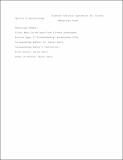| dc.contributor.author | Hartl, Daniel L. | |
| dc.date.accessioned | 2015-10-02T14:35:54Z | |
| dc.date.issued | 2014 | |
| dc.identifier.citation | Hartl, Daniel L. 2014. “What Can We Learn from Fitness Landscapes?” Current Opinion in Microbiology 21 (October): 51–57. doi:10.1016/j.mib.2014.08.001. | en_US |
| dc.identifier.issn | 1369-5274 | en_US |
| dc.identifier.uri | http://nrs.harvard.edu/urn-3:HUL.InstRepos:22898356 | |
| dc.description.abstract | A combinatorially complete data set consists of studies of all possible combinations of a set of mutant sites in a gene or mutant alleles in a genome. Among the most robust conclusions from these studies is that epistasis between beneficial mutations often shows a pattern of diminishing returns, in which favorable mutations are less fit when combined than would be expected. Another robust inference is that the number of adaptive evolutionary paths is often limited to a relatively small fraction of the theoretical possibilities, owing largely to sign epistasis requiring evolutionary steps that would entail a decrease in fitness. Here we summarize these and other results while also examining issues that remain unresolved and future directions that seem promising. | en_US |
| dc.description.sponsorship | Organismic and Evolutionary Biology | en_US |
| dc.language.iso | en_US | en_US |
| dc.publisher | Elsevier BV | en_US |
| dc.relation.isversionof | 10.1016/j.mib.2014.08.001 | en_US |
| dash.license | OAP | |
| dc.title | What can we learn from fitness landscapes? | en_US |
| dc.type | Journal Article | en_US |
| dc.description.version | Accepted Manuscript | en_US |
| dc.relation.journal | Current Opinion in Microbiology | en_US |
| dash.depositing.author | Hartl, Daniel L. | |
| dc.date.available | 2015-10-02T14:35:54Z | |
| dc.identifier.doi | 10.1016/j.mib.2014.08.001 | * |
| dash.contributor.affiliated | Hartl, Daniel | |


